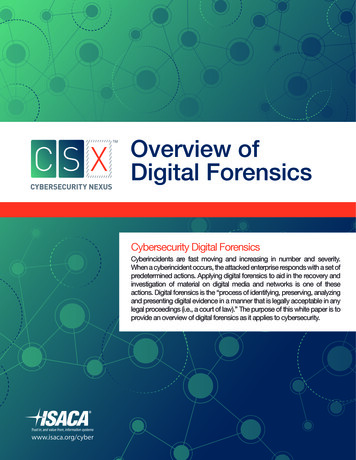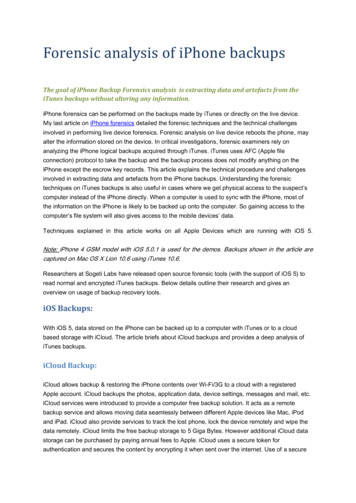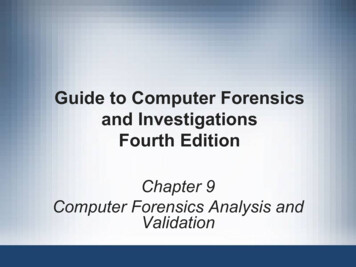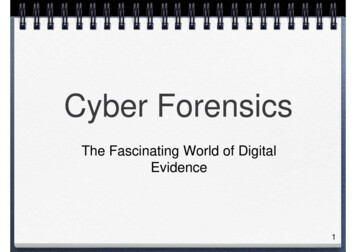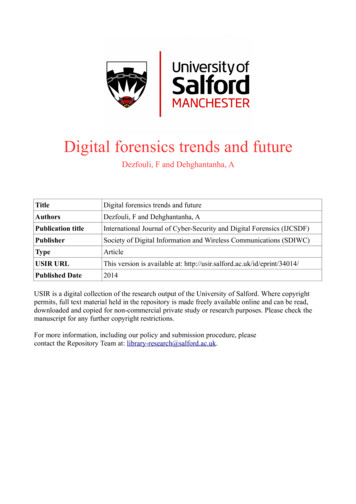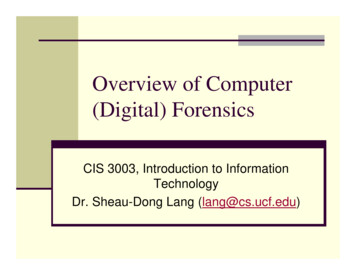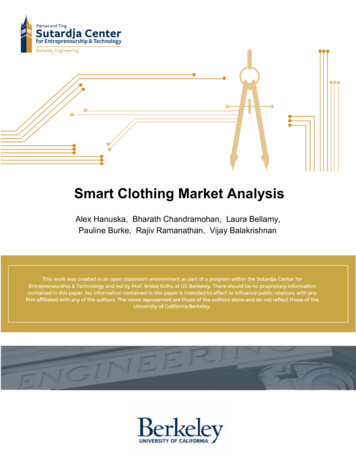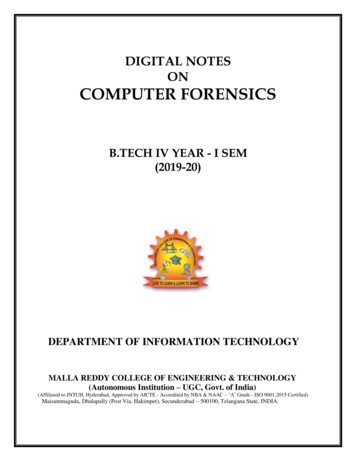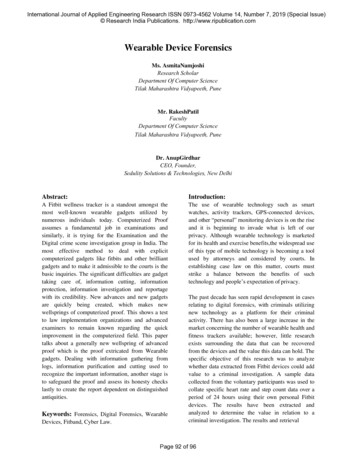
Transcription
International Journal of Applied Engineering Research ISSN 0973-4562 Volume 14, Number 7, 2019 (Special Issue) Research India Publications. http://www.ripublication.comWearable Device ForensicsMs. AsmitaNamjoshiResearch ScholarDepartment Of Computer ScienceTilak Maharashtra Vidyapeeth, PuneMr. RakeshPatilFacultyDepartment Of Computer ScienceTilak Maharashtra Vidyapeeth, PuneDr. AnupGirdharCEO, Founder,Sedulity Solutions & Technologies, New DelhiAbstract:Introduction:A Fitbit wellness tracker is a standout amongst themost well-known wearable gadgets utilized bynumerous individuals today. Computerized Proofassumes a fundamental job in examinations andsimilarly, it is trying for the Examination and theDigital crime scene investigation group in India. Themost effective method to deal with explicitcomputerized gadgets like fitbits and other brilliantgadgets and to make it admissible to the courts is thebasic inquiries. The significant difficulties are gadgettaking care of, information cutting, informationprotection, information investigation and reportagewith its credibility. New advances and new gadgetsare quickly being created, which makes newwellsprings of computerized proof. This shows a testto law implementation organizations and advancedexaminers to remain known regarding the quickimprovement in the computerized field. This papertalks about a generally new wellspring of advancedproof which is the proof extricated from Wearablegadgets. Dealing with information gathering fromlogs, information purification and cutting used torecognize the important information, another stage isto safeguard the proof and assess its honesty checkslastly to create the report dependent on distinguishedantiquities.The use of wearable technology such as smartwatches, activity trackers, GPS-connected devices,and other “personal” monitoring devices is on the riseand it is beginning to invade what is left of ourprivacy. Although wearable technology is marketedfor its health and exercise benefits,the widespread useof this type of mobile technology is becoming a toolused by attorneys and considered by courts. Inestablishing case law on this matter, courts muststrike a balance between the benefits of suchtechnology and people’s expectation of privacy.Keywords: Forensics, Digital Forensics, WearableDevices, Fitband, Cyber Law.The past decade has seen rapid development in casesrelating to digital forensics, with criminals utilizingnew technology as a platform for their criminalactivity. There has also been a large increase in themarket concerning the number of wearable health andfitness trackers available; however, little researchexists surrounding the data that can be recoveredfrom the devices and the value this data can hold. Thespecific objective of this research was to analyzewhether data extracted from Fitbit devices could addvalue to a criminal investigation. A sample datacollected from the voluntary participants was used tocollate specific heart rate and step count data over aperiod of 24 hours using their own personal Fitbitdevices. The results have been extracted andanalyzed to determine the value in relation to acriminal investigation. The results and retrievalPage 92 of 96
International Journal of Applied Engineering Research ISSN 0973-4562 Volume 14, Number 7, 2019 (Special Issue) Research India Publications. http://www.ripublication.commethods are critically reviewed to establish whetherthe potential value of the data outweighs the issuessurrounding the intrusion of privacy and other ethicalconsiderations. These results could provide furthertools and questions to use in investigations wheresuspects or victims own a wearable fitness device topossibly corroborate with other evidence orstatements.In India, people are now more fitness freaks, startedevaluating that up to what extent they are able to burntheir calories, wearable devices which track anindividual’s fitness are becoming increasinglypopular. The devices promote the ability to track yourdaily steps, log what you eat and share progress withan online fitness community or even link deviceswith friends and family to compete in challenges.Wearable fitness trackers are a popular way to stayactive and in control of personal fitness levels via asmall device worn on the wrist, like a digital watch.A fitness tracker uses an accelerometer, a smallinstrument that measures acceleration forces, tocalculate physical activity.Large companies such as Fitbit, Samsung, and Appleencourage users to track their health and lifestyleusing online platforms linked to the device itselfusually via an app (Fitbit, 2018). The devices are stillimproving and most include basic functions such asstep tracking and heart rate monitoring. However,newer versions of the devices also allow users totrack sleep patterns, GPS locations and also log exactwork outs. The devices also include the option for theuser to log food and water intake to track theircalories throughout the day. These devices collatespecific data that can then be used to gain furtherinsight into an individualHowever, Law implementation organizations arebeing tested by the need to prepare their staff toremain exceptional because of the quickly developingnature of new innovations in the advanced field. [1].There are a few attributes relating to the idea ofadvanced proof that recognizes it from the run of themill proof. Computerized proof can be time delicate,dormant (covered up), and can be effectivelychanged, harmed or annihilated [2]. Furthermore,computerized proof crosses jurisdictional limits,which introduces significantly more noteworthydifficulties for advanced examiners and lawauthorization authorities. A measurable expert mustensure that the strategies utilized are completelyagreeable with every single appropriate law andguidelines in that specific locale [3].In this paper, distinctive wellsprings of computerizedproof are talked about, with the attention being onWearable gadgets as advanced proof. A contextualanalysis identified with this specific computerizedproof is exhibited.The rest of this paper is organized as follows: theprocess of digital forensic investigation is presentedin section 2. An overview of the different sources ofdigital evidence is presented in section 3. Purpose pfthe proposed Algorithms is to store the relevantvalues and further use for the analysis andinvestigation purpose. 4. A discussion of thechallenges of using Wearable’s as digital evidence ispresented in section 5, and a conclusion is presentedin section 6.Process of Digital Forensic InvestigationGadget Forensic analysis might be required in a widerange of circumstances, for example, proofaccumulation for legitimate procedures, and insidecorporate examination of Security Arrangementinfringement [4]. The strategies and devices utilizedby scientific specialists may differ contingent uponthe kind of occurrence and the sort of exploredcomputerized proof, subsequently a characterizedmethod is required to oversee the procedure ofadvanced examination and follow industrybenchmarks and fitting laws [5]. There are differentproposed models for Digital Forensics. In any case,the five stages utilized in research areas illustrated inFigure 1 Phases of Digital Forensics process.Collection of Data Data filtering - DataAcquisition - Identification & Analysis- ReportingFigure 1:Phases of Digital Investigation Process.For the most part, an advanced criminologicalexamination begins with the distinguishing proof ofthe episode and the recognizable proof of thewellsprings of computerized proof. At that point, acourt order is issued by the appointed Lawrequirement office to gather and break down theadvanced proof. The measurable specialist mustknow that the utilization of inappropriate system orunlawful pursuit and seizure can contrarily influencethe tolerability of the proof [5]. When the court orderreceived, the criminological examiner will set up theapparatuses and the procedures required for whateverPage 93 of 96
International Journal of Applied Engineering Research ISSN 0973-4562 Volume 14, Number 7, 2019 (Special Issue) Research India Publications. http://www.ripublication.comremains of the procedure. The five phases of theprocedure are then pursued as portrayed underneath:An overview of the different sources of digitalevidenceCollection of DataThe Gathering stage alludes to the accumulation ofadvanced proof from the different sources identifiedwith the episode being explored. When gathering theproof, it is important that no progressions are made tothe first information. For instance, when gatheringproof structure a PC hard plate, a criminologicalduplicate of the information put away on the hardcircle is taken so as to play out the examination onthat duplicate. An exceptional gadget called acompose blocker is utilized amid the duplicatingprocedure to keep any progressions totheinformation on the hard plate [6].The gathering stage is of most extreme significanceas whatever is left of the stages rely upon the presentaccumulation of proof. Two basic factors in this stageare the Realness of the proof information gathered,and the Safeguarding of the advanced proof. Therealness of advanced proof alludes totheconfirmation that the proof has not been modifiedand that it originates from a specific source. InGovernment Courts, legitimacy is administered byStandard 901(a), which expects that to build up that athing is bonafide, a defender must deliver allowableproof "adequate to help a finding that the thing is thething that the advocate claims it is." [7]The conservation of computerized proof alludes tofollowing generally accepted procedures and ruleswhen dealing with the proof. The most critical rulesare as per the following [6]: Guarantee that every advanced proof gathered islegitimately archived, named, checked, shot,video recorded or outlined, and stocked. Guarantee that extraordinary consideration istaken with the computerized confirmationsmaterial amid transportation to maintain astrategic distance from physical harm, vibrationand the impacts of attractive fields, electricalstatic and substantial variety of temperature andmugginess. Guarantee that the advanced proof is put away ina safe, atmosphere controlled condition or anarea that isn't liable to extraordinary temperatureor dampness. Guarantee that the advanced proofisn't presented to attractive fields, dampness,residue, vibration, or whatever other componentsthat may harm or pulverize it.Data FilteringData Filtering is the way toward picking a little pieceof your informational index and utilizing that subsetfor review or examination. Separating is for the mostpart (yet not constantly) transitory – the totalinformational index is kept, however just piece of itis utilized for the estimation.Separating might be utilized to: Look at results for a specific timeframe. Calculate results for specific gatherings ofintrigue. Exclude wrong or "awful" perceptions from anexamination. Train and approve factual models.Sifting expects you to indicate a standard or rationaleto recognize the cases you need to incorporate intoyour investigation. Sifting can likewise be alluded toas "sub-setting" information, or an information "drilldown". In this article, we show a sifted informationalindex and talk about how you may utilize separating.Data AcquisitionThe following stage after the information filtration isinformation securing. It is the way toward examiningsignals that measure true physical conditions andchanging over the subsequent examples intocomputerized numeric qualities that can be controlledby a PC. Information procurement frameworks,condensed by the abbreviations DAS or DAQ,normallyconvertsimplewaveformsintocomputerized esteems for handling. The parts ofinformation procurement frameworks include: Sensors, to change over physical parameters toelectrical signs. Signal molding hardware, to change over sensorsignals into a structure that can be changed overto computerized values. Analog-to-computerized converters, to changeover molded sensor signs to advanced qualities.For this situation, the most part alluding to therecovery of material from a gadget, when contrastedwith the bit duplicate imaging utilized in PC legalsciences. The information gained from thelogs/metadata is as parameters which should bepreserved for the further examination andinvestigation. Wearable’s are restrictive in nature, ina couple of devices, it is hard to extricate and gaininformation which meets to an impasse. Anyway onthe off chance that the information gets removed thenit further arranged by a continuum, along whichstrategies turn out to be progressively specialized and"forensically stable," apparatuses turn out to beincreasingly costly, examination takes longer,inspectors need all the more preparing, and a fewtechniques can even turn out to be progressivelyintrusive.Page 94 of 96
International Journal of Applied Engineering Research ISSN 0973-4562 Volume 14, Number 7, 2019 (Special Issue) Research India Publications. http://www.ripublication.com2.Second method is to analyze the userstepsFitbit steps(uid,starting timestamp,ending timestamp, steps count, location){Calories burned log file function to calculate burned calories forspecific uid(uid,start timestamp,ending timestamp, step count, location);returncalories burned log file;}The Identification and analysis phaseThe Identification and analysis phase alludes todissecting the information coming about because ofthe examination stage to achieve suitable endsdependent on the proof found or verify that no endcan yet be drawn. The examination ought toincorporate recognizing individuals, spots, things,and occasions, and deciding how these componentsare connected to an end can be come to. Thespecialized information and experience of the expertassume a noteworthy job in playing out a powerfulexamination. The investigation ought to be ledutilizing legitimately reasonable strategies andprocedures [4] & [8].The Reporting PhaseThe Reporting Phase alludes to the way towardgetting ready and showing the data coming aboutbecause of the investigation stage. It accomplished byshowing the proof and the examiner's decision to theindividual or gathering asking for the digital forensicsexamination [6].Proposed AlgorithmsMany Controversial criminal cases now registered inIndia where the suspected pieces of evidence areattached along with more digital evidence as a part ofreports.Due to the latest trends of the usage of digitalgadgets, especially Fitbit's the admissibility of thedigital evidence in the court is another challengingphrase.In this research, the proposed algorithm benefits forfurther research and development dedicated to theInvestigations agencies and produce digital evidence.The list of proposed algorithms is as follows:1. First method is to prepare the usersprofilefitbit profiles(uid,fullname,birthday,profile image,height,gender,avg walking stride,avg running stride,timezone, country, location){# log in all parameterslogfile uid fullname birthday profile image height gender avg walking stride avg running stride timezone country location;return logfile;}3. Third Method is to analyze heart ratesFitbit heart rate(uid, starting timestamp,ending timestamp,average heart beat,location){Heart rate log file function to calculate heart rate for specific uid(uid,start timestamp,ending timestamp, avg heart rate in BPM, location);returnHeart rate log file ;}Further, these proposed algorithms use to save theuser data to day activities in the form of logs which issubject to analysis the behavior of the user. Forexample, the user is in sleep mode, walking mode,running mode, mental stress, correlated to thetimestamps and the location as well. It is very muchsupportive for further investigation and easy to makeit admissible in front of the court.Challenges on using Wearable’s DigitalEvidenceAlthough computerized proof removed fromWearable gadgets has been utilized in a few lawfulcases as talked about above[9], [10] & [11]; there area few difficulties with Wearable proof that may beutilized to discredit the legitimacy and unwaveringquality of the proof. As we would like to think, thesedifficulties can be classified into legitimatedifficulties, operational difficulties, and abusedifficulties as pursues:1. Legitimate difficulties: Computerized information proof social event isnew and wrongdoing scene police may not beproficient in how to gather, secure, transport orstore advanced information to guaranteeinformation isn't undermined or lost. Only one out of every odd law implementationoffice has research centers or confirmedscientific specialists to analyze and translateinformation from Wearable gadgets.Page 95 of 96
International Journal of Applied Engineering Research ISSN 0973-4562 Volume 14, Number 7, 2019 (Special Issue) Research India Publications. http://www.ripublication.com2. Operational Difficulties: The time-stamp inside the Fitbit can be set to anincorrect time, consequently the season of theoccasions won't be exact, and connection withother computerized proof won't be conceivable. Fitbit relies upon GPS for informationtransmission and following. GPS requires animmediate way to the satellite it is utilizing forlegitimate information transmission. On the offchance that the GPS flag is being hindered forreasons unknown - the client is underground,climate conditions – at that point the informationgathered won't be exact. Numerous models of Wearable gadgets areaccessible available, each with its very ownarrangement of highlights and capacities. Not allgadgets give similar usefulness and translation ofdevelopment. For instance, a few models won'trecognize arm development from real advances,and subsequently, their information recordswon't be solid.3. Abuse Difficulties More than one individual may wear a Fitbit. The information records from the Fitbit are exactas long as the client is wearing the gadget andutilizing it legitimately. For instance, wearing thegadget on the lower leg will create conflictinginformationConclusionComputerized scientific examination has growngigantically amid the ongoing years. The coming ofnew gadgets that store information has been trying tomeasurable examiners and law authorization offices.New measurable examination apparatuses andstrategies were and as yet being created so as toalmost certainly process and break down informationfrom these gadgets. PCs and cell phones are the mostwell-known wellsprings of computerized proof; inany case, it has been demonstrated from numerouslawful cases that there are different wellsprings ofsignificantly advanced proof.Wearable gadgets store unlimited measures ofinformation about the client's area, movement levels,rest designs, and moving propensities; in this mannermaking a nitty-gritty story of the client's regular dailyexistence. Proof removed from Wearable gadgets hasnot yet been utilized on a wide scale because ofcontentions in regards to the unwavering quality andexactness of these gadgets. Be that as it may, thesegadgets are being improved persistently, theirexactness and unwavering quality and along theselines, acceptability is improving extraordinarily whenthey are matched up to different gadgets like cellphones and PCs which are now utilized as allowableproof in court.Gave that the proof meets the prerequisites ofacceptability, Wearable gadgets ought to beconsidered as one of the wellsprings of advancedproof that can be useful in numerous legitimate cases.References[1] NIJ, “Digital Evidence and Forensics.” nsics/evidence/digital/Pages/welcome.aspx. [Accessed: 20-Aug-2003].[2] N. C. J. U.S. Department of Justice, “ElectronicCrime Scene Investigation: A Guide for FirstResponders,” NIJ Res. Rep., no. NCJ 187736, p. 96,2001.[3] S. Sivanathan, “Digital Evidence ManagementFramework For Computer Forensics.” ntent/pid 98/.[4] K. Kent, S. Chevalier, T. Grance, and H. Dang,“Guide to integrating forensic techniques intoincident response,” 2006.[5] J. T. Ami-Narh and P. A. H. Williams, “Digitalforensics and the legal system: A dilemma of ourtimes,” 6th Aust. Digit. Forensics Conf., pp. 30–40,2008.[6] H. Guo, B. Jin, and D. Huang, “Research andreview on computer forensics,” Lect. Notes Inst.Comput. Sci. Soc. Telecommun. Eng., vol. 56, pp.224–233, 2011.[7] H. O. N. P. W. Grimm, for Authenticating DigitalEvidence. 2016.[8] C. Harrell, “Overall DF Investigation ess.html.[9] Sarah Griffiths, “Fitbit data is now being used al-injuryclaims.html.[10] Kate Pickels, “Police claim woman lied ged-bed.html.[11] J. N. Goldman, “The Fitbit Murder and Our es/.Page 96 of 96
Forensics, Digital Forensics, Wearable Devices, Fitband, Cyber Law. Introduction: The use of wearable technology such as smart watches, activity trackers, GPS-connected devices, and other “personal” monitoring devices is on the rise a
